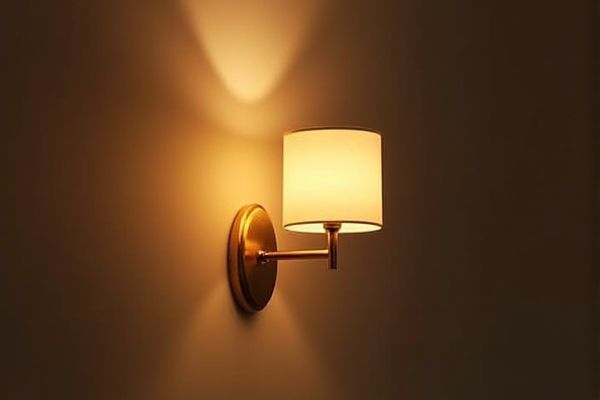
Sconce lighting offers a subtle, wall-mounted option that enhances ambient light and saves space, while pendant lighting provides a bold, eye-catching centerpiece ideal for task illumination and style statement. Explore the rest of the article to discover which lighting choice best complements your space and needs.
Table of Comparison
| Feature | Sconce Lighting | Pendant Lighting |
|---|---|---|
| Installation Location | Mounted on walls | Hangs from ceiling |
| Purpose | Ambient or accent lighting | Task or ambient lighting |
| Space Utilization | Space-saving, ideal for narrow areas | Requires ceiling clearance |
| Light Direction | Upward, downward, or both | Focused downward light |
| Design Style | Traditional to modern options | Contemporary and decorative styles |
| Common Uses | Hallways, bathrooms, living rooms | Dining rooms, kitchens, entryways |
| Installation Complexity | Moderate; requires wall wiring | Moderate; requires ceiling wiring and support |
| Cost Range | Generally affordable to mid-range | Mid to high range depending on design |
Introduction to Sconce and Pendant Lighting
Sconce lighting fixtures are wall-mounted and provide ambient or accent illumination, commonly used in hallways, bathrooms, and living rooms to enhance architectural features. Pendant lighting hangs from the ceiling by a rod, chain, or cord, delivering focused task lighting ideal for kitchens, dining areas, and entryways. Both lighting types serve functional and decorative purposes, with sconces offering subtle, space-saving lighting and pendants adding visual interest and height to a room.
Design and Aesthetic Differences
Sconce lighting typically offers a wall-mounted design that creates ambient or accent lighting with a more subtle, decorative flair, ideal for highlighting artwork or architectural features. Pendant lighting hangs from the ceiling and serves as a focal point, providing direct illumination and often embodying bold, sculptural aesthetics that enhance the room's style. Choosing between your sconce or pendant fixtures depends on whether you want to emphasize wall space with layered lighting or make a statement from above.
Installation Requirements and Complexity
Sconce lighting typically requires straightforward installation, often mounted directly onto walls with basic wiring, making it accessible for most DIY enthusiasts and suitable for spaces where floor or ceiling access is limited. Pendant lighting demands more complex installation due to ceiling mounting that frequently involves securing fixtures to joists or support beams and handling longer electrical runs, which may necessitate professional expertise, especially for high or vaulted ceilings. Your choice between sconce and pendant lighting should consider the ease of installation based on your room's architecture and your comfort level with electrical projects.
Space Utilization and Room Suitability
Sconce lighting maximizes space by mounting directly on walls, making it ideal for narrow hallways, small rooms, or areas with limited ceiling height. Pendant lighting requires overhead space and works best in open or spacious rooms like dining areas, kitchens, or entryways where it can serve as a focal point. Both lighting types enhance room functionality and aesthetics, but optimizing space utilization depends on room dimensions and ceiling height.
Lighting Direction and Coverage
Sconce lighting typically directs light upward or downward, providing localized illumination that accentuates wall features and creates ambient mood lighting with limited coverage. Pendant lighting hangs from the ceiling, casting focused or diffused light downward, making it ideal for task lighting and broader area coverage such as over kitchen islands or dining tables. Choosing between sconce and pendant lighting depends on your desired lighting direction and how much space you want to illuminate effectively.
Versatility in Interior Styles
Sconce lighting offers versatility in interior styles by blending seamlessly with both traditional and modern decor, enhancing wall spaces without overwhelming the room. Pendant lighting provides a focal point with adjustable height and design variety, making it ideal for kitchens, dining areas, and living rooms to create ambiance or task lighting. Both lighting types accommodate diverse aesthetics, but sconces are better suited for subtle, ambient illumination while pendants excel in statement-making and functional lighting.
Energy Efficiency and Light Source Options
Sconce lighting offers energy-efficient options such as LED bulbs and compact fluorescents that consume less power and provide focused illumination ideal for ambient or accent lighting. Pendant lighting also supports energy-saving technologies, including dimmable LEDs and smart bulbs, allowing customizable brightness and color temperature for task or decorative purposes. Both fixtures accommodate various light sources, but sconces typically use lower wattage bulbs, making them more energy-efficient for smaller spaces or subtle lighting needs.
Maintenance and Accessibility
Sconce lighting offers easier maintenance and accessibility due to its wall-mounted design, allowing quick bulb replacement and cleaning without requiring ladder use. Pendant lighting often requires more effort for upkeep, as fixtures hang from the ceiling, making bulb changes and dusting more challenging, especially in high or hard-to-reach spaces. Choosing sconce lighting enhances convenience in maintenance tasks, while pendant lighting may require professional assistance for safe and efficient upkeep.
Cost Comparison: Sconces vs Pendants
Sconce lighting generally costs less than pendant lighting due to simpler installation and smaller fixture sizes, making sconces a budget-friendly choice for wall-mounted illumination. Pendant lights often require more complex wiring and ceiling mounting, which can increase labor expenses and overall project costs. Your decision may depend on the balance between aesthetic preference and budget, as pendants tend to offer more dramatic visual impact at a higher price point.
Choosing the Right Fixture for Your Space
Sconce lighting offers a subtle, wall-mounted option ideal for ambient or accent lighting, making it perfect for hallways, bathrooms, or small spaces where floor space is limited. Pendant lighting provides a more prominent, hanging fixture that delivers focused illumination, enhancing dining areas, kitchen islands, or entryways with both style and functionality. Choosing the right fixture depends on your space's size, ceiling height, and desired lighting effect to balance aesthetics and practicality.
 homyna.com
homyna.com